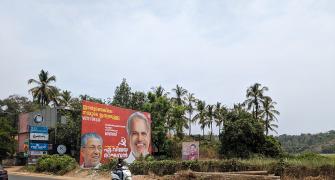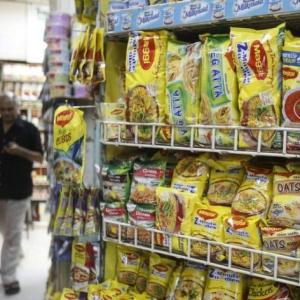In the first of a two-part series, Sanjeeb Mukherjee examines the impact of the upcoming summer on agriculture and drinking water supply.

Summers have set in and if weather predictions and current day temperatures are any indication, the country is in for an extended period of extremely dry and warm weather.
While this could put a strain on drinking water supply and animal fodder in some parts, the sudden rise in temperatures might not take a toll on the standing crop of wheat, mustard and gram.
The bulk of the last two has been harvested. But it might slow vegetable supplies and push up prices.
Meteorological data shows temperatures in and around the National Capital Region and other northern cities have been hovering at over 30 degrees, 3-7 degrees higher than the historical average.
The India Meteorological Department (IMD) has predicted above normal temperatures in all sub-divisions during March-May and weather officials and experts said the region should brace up for more intense heat in the coming months.
In fact, weathermen said there was a high probability that the incidence of heatwaves may rise this year, particularly in the northwest and central parts of the country.
An unusually dry winter followed by a lack of normal pre-monsoon showers is also expected to keep the weather warm and dry.
A big disturbance has been predicted over the Arabian Sea, which might develop into a cyclonic storm in the next few days, but it is likely to be limited to the coastal parts of Tamil Nadu, Kerala, and Lakshadweep.
Momentary relief from scorching heat is expected in the northern parts of the country in the next few days.
The shortfall in rain in January and February was over 60 per cent, followed by a 30 per cent shortfall since March 1.
North and central India bore the brunt of this shortfall. The forecast shows India might have fewer pre-monsoon showers.
“Generally, we expect the heatwave to start in April largely over Telangana, Vidharbha, Rajasthan, Gujarat, north interior Karnataka and isolated places in Odisha, where temperatures could rise to over 40 degrees Celsius,” Mahesh Palawat, chief meteorologist at private weather forecasting agency Skymet told Business Standard.
The IMD, in its forecast last month, had said there was a 52 per cent probability that the grid-point maximum temperatures in the core heatwave zone could be above normal between March and May.
Core heatwave zones cover Punjab, Himachal Pradesh, Uttarakhand, Delhi, Haryana, Rajasthan, Uttar Pradesh, Gujarat, Madhya Pradesh, Chhattisgarh, Bihar, Jharkhand, West Bengal, Odisha, Telangana and the meteorological subdivisions of Marathwada, Vidarbha, Madhya Maharashtra and coastal Andhra Pradesh.
“Day temperatures have risen in some parts but night temperatures are still favourable, which means there might not be a big effect on the standing wheat crop in Punjab, Haryana and western Uttar Pradesh where the crop is still green,” said G P Singh, director of the Karnal-based Indian Institute of Wheat and Barley Research.
Singh said the standing crop was well into the maturing phase in other key wheat-growing states, such as Maharashtra, Gujarat and Madhya Pradesh, which saw a sudden rise in temperature.
“Overall wheat production in the country is on course to cross the initial estimate of 96-97 million tonnes (mt),” Singh said.
The marginal drop in acreage is also not expected to dent output in 2018-19.
But a long summer season could have serious implications for drinking water and power supply, particularly in areas where the water level in reservoirs has declined and ground water is insufficient.
The Central Water Commission data shows that as on March 8, Sardar Sarovar Dam in Gujarat, considered the lifeline of the state, has almost no water.
This contrasts with 19 per cent of the full-capacity level in the corresponding period last year.
The overall water level was almost 6 percentage points lower in the 27 reservoirs in Gujarat and Maharashtra than in the same period last year.
Across the country, the water level in 91 reservoirs was lower, as on March 8, than recorded in the same period last year.
“First the southwest monsoon was deficient in some parts, then the winter rain was lower than normal and snowfall was lower, which is why the quantum of meltwater will be lower.
"Additionally, a warmer-than-usual summer has been predicted. Clearly, we have a problem on our hands in the coming months, and if the monsoon is delayed, the situation could become worse,” said Himanshu Thakkar of the South Asia Network on Dams, Rivers and People (SANDRP).
Thakkar said parts of Gujarat, Uttarakhand, most of south India, Odisha and Chhattisgarh were most vulnerable to a water crisis in the coming months due to low rainfall and a declining water table over the last several years.
The government had conducted a meeting with National Disaster Management Authority and IMD officials in Hyderabad a few weeks ago to take stock of the situation, particularly in nine cities such as Ahmedabad and Bhubaneshwar.
City-specific action plans have been prepared and discussed with the states.
These include steps such as an emergency response mechanism in hospitals, shifting children wards to cooler areas, and setting up of additional drinking water kiosks.
“Since last year, we have strengthened our heatwave advisories and will further fine-tune them with district-level predictions so that a proper action plan can be prepared,” said IMD Director-General K J Ramesh.
Photograph: Tim Sharp/Reuters.










